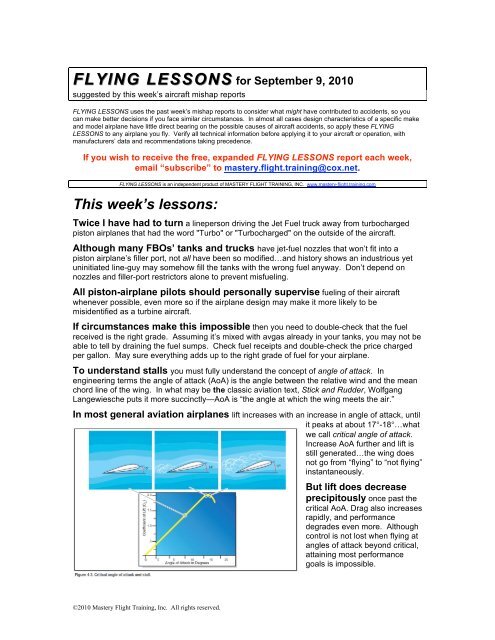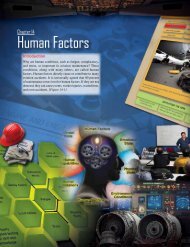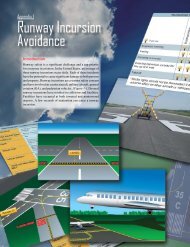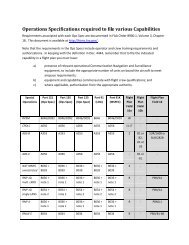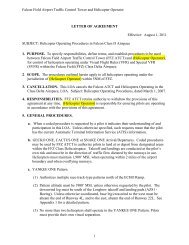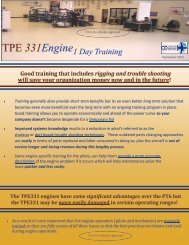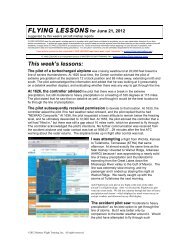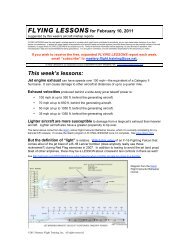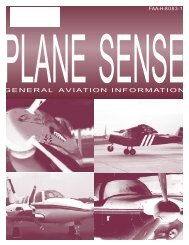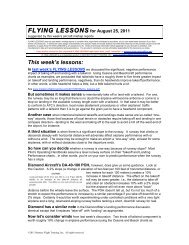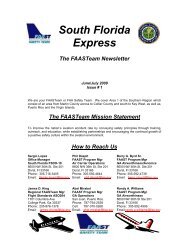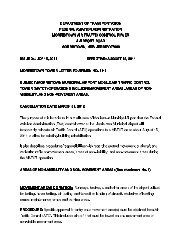FLYING LESSONS 100909.pdf - FAASafety.gov
FLYING LESSONS 100909.pdf - FAASafety.gov
FLYING LESSONS 100909.pdf - FAASafety.gov
Create successful ePaper yourself
Turn your PDF publications into a flip-book with our unique Google optimized e-Paper software.
Reader John Hodgson writes about stalls:I don't accept that even a student pilot will only react to a stall after it occurs (if that was the intentof the comments). That is lousy training. The six impending signs of a stall, which should beobvious to anyone who is well trained and current, are:oooooooreducing airspeed, as seen on the ASIincreasing deck anglereducing noise levelcontrols getting sloppybuffet felt through the sticksense of kinesthesia, (through the seat of your pants), andthe stall warning horn [and/or light].A CFI who will not stall a training aircraft is not meeting their obligations to keep the student safeand should not be instructing.Stalls should be reviewed and practiced no less often than the biannual Flight Review. Power on,power off, straight and level and accelerated. Incipient and developed. Recovery from the onset ofthe buffet to holding wings level in deep stalls (which show the rapid rate of descent).An aerobatic pilot will be aware of the stall well before it occurs and already have determined theresponses that will depend on what is the next intended maneuver.Excellent, John, and I agree. In last week’s <strong>FLYING</strong> <strong>LESSONS</strong> I quoted the FAA Practical TestStandards (PTS) for the different levels of pilot certification not to advocate a higher level ofproficiency for pilots with “lower” certification; in fact my goal was the opposite, to point out thePTS do not require “full” stalls in the higher levels and, since stalls are not required in FlightReviews, that a more experienced pilot may have gone far longer since practicing stalls than anewer aviator. You have reached the same conclusion—that currency in stall recognition andrecovery is a function of the Flight Review and other recurring training and practice,recommended for all pilots regardless of the certificate held.<strong>FLYING</strong> <strong>LESSONS</strong> reader and widely published author Mike Busch writes:Tom, your most recent issue of Flying Lessons prompts the following comments:Normally aspirated multiengine airplanes frequently reach aerodynamic stall before loss of directionalcontrol capability in a Vmc demo. The engines develop less power when at a safe Vmc demo altitude.Therefore there is less asymmetric thrust and wing stall speed is reached first.Nowadays, with the advent of STC'd vortex generators which (among other things) greatly improve rudderauthority at low speeds, even turbocharged piston twins often have Vmc lower than Vsi.Some airplane brakes are very effective, and effectiveness means lots of friction, which in turns means heat.Be especially careful to restrict hard braking to only when it’s needed. Otherwise, control taxi speedprimarily with power, using brakes as little as possible.Also, to the extent that braking must be used to control taxi speed (and/or to provide directional control whentaxiing tricycle-gear aircraft with a free-castering non-steerable nosewheel), the use of brakes should beconfined to brief episodes of firm brake application punctuated by long intervals of brake non-use, rather thancontinuous light brake application (a.k.a. "dragging the brakes."). This problem has historically beenparticularly epidemic with the Cirrus SR22, because it has (1) a non-steerable nosewheel, (2) a very largeengine for its weight with consequent very high idle thrust, and (3) a fixed gear with tight wheel fairings thatlimit the flow of cooling air to the brakes. These aircraft have a history of brakes catching fire, which wasaddressed both by an Airworthiness Directive and by an aggressive campaign of pilot education in the Cirruscommunity. The AD requires (among other things) that the brakes be fitted with temperature-sensitivestickers that turn dark if the brakes have been over-temped. Checking the color of the stickers is a pre-flightitem as well as a 50-hour maintenance item.In reading the accident reports, it appears that there is a potential common cause. Two recent accidentsshared the same "recent registration". Could it be that inadequate pre-purchase inspections are the culprit?©2010 Mastery Flight Training, Inc. All rights reserved.
While it could be true for those two specific accidents, I don't think it's true in general. It's a safe bet that theoverwhelming majority of "recent registration" accidents are caused by low time in type by the pilot, notinadequate pre-purchases inspection by the mechanic. Historically, at least three-quarters of accidents arecaused by the pilot and less than one-quarter by the machine. Also historically, only about half of themachine-caused accidents are caused by inadequate or incompetent maintenance.Excellent comments all, Mike. Thank you. Regarding the earlier reader comment about “recentregistration” mishaps, I agree that the biggest contributor to accidents is most certainly low pilotexperience in type. In fact that’s why I track the statistic, to point out the very real need fortransition into a new airplane regardless of pilot experience or if the new airplane is “less capable”than what the pilot has usually flown. Reader George Wilhelmsen (whose comment you quoted)suggests that maintenance may be an issue in some “recent registration” mishaps, pointing outthe need for a good prepurchase inspection and for the new owner to aggressively pursue anymechanical squawks on the airplane. New owners should be aware of both issues and how theymay affect safety.Reader and instructor pilot Dan Ramirez provides a tip about engine failures in twin-engineairplanes:As always, I enjoy the awesome information you and your readers put out! One thing I may add if youplease, When I instruct in twins, I always suggest that the pilot always keep his heading bug on the coursebeing flown. After awhile it becomes second nature. Why do I think it is so important? Well, I have flownwith many experienced twin drivers who could not tell me a foolproof way of identifying a sick or deadengine in IMC. The solution is simple. STEP ON THE BUG!!!When the heading bug moves to the right, step on the right rudder! When the bug moves to the left, step onthe left rudder! Your dead foot immediately tells you what engine gave up the ghost! I practice this with alltwin drivers under the hood and I have even done it in IMC. Works great and builds confidence quickly!Thanks again for your concern for everyone's safety!Thank you, Dan, for yours.Twin TimeQuestions from two readers this week concern multiengine operations:Baron 55 pilot Gregg Goodall writes:Hey Tom. I religiously read your weekly newsletter and thoroughly enjoy it.Being a new multi-engine pilot, I read the current article about loss of engine with particular interest. I wastaught and agree with what you and the contributor have written with one exception that I would like youropinion on.The background is this: after taking my check ride, I had to have 10 hours of dual in the Baron before I couldsolo. So, I hired a local instructor who is a retired airline captain and now flies King Airs for a living. In hisearly days, he ferried all models of Bonanzas and Barons across the country for a dealer and so he hasconsiderable time and experience in all Beech models. He is also an AP/IA and a friend I have known forquite some time. So this seemed to be a good choice for me. During this training, we went thru all of thecheck ride maneuvers and all was good for him except one thing. On take-off and upon reaching rotationspeed, he had me remove my right hand from the throttles and place it on the yoke. He said that at the pointof rotation, unless you were on an exceptionally long runway at a major airport (which was highly unlikely),the only decision was to continue the take-off, pitch for blue line and go straight ahead and that there shouldbe no temptation to retard a throttle or anything else at that point or to go thru the identify verify routine.Once the airplane is under control and, if and when time permits, then go straight for the prop lever for theengine on the side that you swing to…dead foot dead engine…and feather it. Then, if time permits, go thruthe emergency checklist.Made sense to me so that is what I am doing. What do you think?©2010 Mastery Flight Training, Inc. All rights reserved.
I replied: At anything except the very lightest weights, a Baron (like most light twins) cannotaccelerate out of an engine failure with the gear down, even if you feather the correct propellerimmediately and retract the landing gear right away. Attempting to climb out will almost certainlyresult in an extremely rapid deceleration toward Vmc. This is why we emphasize “positive rate,gear up” in multiengine airplanes...because the riskiest part of a twin-engine takeoff is the timebetween liftoff and retraction of the landing gear.Consequently your best chance of survival of an engine failure right at takeoff is to “chop thethrottles” immediately, lower the nose and land straight ahead. Because you’ll have a halfsecond or more of denial, followed with as much as a second to react, I feel you need to haveyour hands on the throttles to be ready to chop the throttles before the airspeed becomes critical.Here’s what I teach as a “line-up litany” for every takeoff takeoff in a twin:• If the gear is down, I’m going down• If the gear is up, three degrees upThat latter item comes from the fact that in Barons (and many light twins) will attain “blue line”speed at about three degrees UP attitude, if the gear and flaps are up and the “dead engine”propeller is windmilling. Immediately adjusting attitude to three degrees above the horizon willprovide the best possible performance at that point if the gear and flaps are up. This meansmaximum climb or minimum descent, depending on airplane weight and density altitude. Afterfeathering the propeller drag is reduced and a higher pitch attitude (seven degrees UP, to beexact) causes the airplane to fly at blue line.Your extremely experienced instructor may well be able to fly an “accelerate-go” takeoff if anengine gives out at exactly the wrong time. But I have instructed dozens (maybe hundreds) ofBaron pilots in the FlightSafety simulator, and virtually none of them were able to fly out of anengine failure while the gear was still down. From that experience I wouldn’t try it myself, and Iteach my students to acknowledge there’s a short period of extra risk after liftoff and before thegear is up, when the best option is to land straight ahead just as you would if the engine gave outin a single-engine airplane.Gregg responds:Kudos to you my friend. Best explanation yet!!!!!. I am a changed Baron pilot. I do believe he would haveme get the gear up but that’s too much to remember at those critical moments. I feel safer already knowing Iwill employee these principles.Reader Keith Duce, who flies a Cessna T303 turbocharged twin out of Archerfield (nearBrisbane), Australia, writes:I had a moment in the Crusader brand back a few weeks ago when the return oil line from the turbo broke atthe elbow fitting. It was interesting how the training kicks in and everything slows down and becomesmanageable. I guess that I was lucky also that I was over an airfield in CAVOK conditions and daytime andthat the oil gushing out of this line was coming out of the top louvre vent not the bottom…. I did not shutdown the engine but immediately throttled back to idle and monitored the leak and oil pressure on the waydown with the idea of shutting down the engine if the pressure dropped. After the event I was annoyed withmyself for not immediately shutting down the engine and I thought that I might have damaged the engine.The engine still had 3 quarts left in it and the pressure only dropped on short final. The engine builder andthe LAME both said that in their opinion I did the correct thing. What is your feelings on this?In a twin you have a lot of options when faced with an oil leak. I'm concerned, however, abouttwo things:1. Fire hazard. You don't know where that mist of oil is going. Especially if it is near theturbocharger or exhaust manifold, it presents a serious risk of fire. This in turn could takeout some fuel lines. There have been isolated cases of fires quickly burning through thefront spar of turbocharged airplanes.©2010 Mastery Flight Training, Inc. All rights reserved.
2. Total engine failure. With oil loss there will, eventually, come engine failure. Before thatoccurs you may have an uncommanded propeller feather, as oil pressure drops in theprop dome. I'm not as concerned about preserving the mechanical condition of theengine to reduce repair costs (although those costs may be significant). I'd just rather tohave the engine failure and/or propeller featuring happen on my schedule. I'd hate to beturning onto final approach and have the prop unexpectedly feather, for instance, or haveto deal with an engine failure inside the Final Approach Fix in IMC.It'd be even worse if some unrelated factor required you fly a balked landing or a missedapproach, and the engine would quit on the initial climbout. To get the failure over with I'd rathercause it myself, i.e., at altitude and with plenty of airspeed, I'd pull out the Engine Shutdown andSingle-Engine Approach checklists, review them both, then use the Shutdown checklist to featherthe correct propeller and secure the engine. Then, I'd set up for and fly a single-engine approachand landing.We call it "Monday morning quarterbacking" here, and I don't have all the indications and detailsyou had when faced with the decision, but in general that's what I would probably do.Nonetheless, you accomplished the primary goal of getting everyone down safely, and thesecondary goal of doing so with the airplane in a condition where it may be used again. So asyou say, good on you, Keith!Keith replied:Thanks for the feedback. I never even considered the possibility of a fire but this is a real possibility. Theonly thing that may have prevented this is that there was so much oil coming out that it might have put thefire out. Faced with the same problem again and lets hope that this does not occur I would follow youradvice. The idea of shutting the engine down and getting nicely on top of the situation whilst I am at 9000ftmakes good sense. In some ways being over an airfield took away the option in my mind of shutting downthe engine and I guess my primary focus was on getting down on the ground to assess the situation andsecondly saving the engine. In hindsight the decision was wrong and in fact very wrong. The thing that Ilove about flying is that I never stop learning. Thanks again for the advice. I wish that you were closer andwe could do some flying training together.Next time I’m Down Under we’ll fly together (again).New FAA Online Course on Taxi and Ground ProceduresThe U.S. Federal Aviation Administration announces a new, free online course on two majorprocedural changes affecting Taxi and Ground Movement Operations. Pilots now require an ATCclearance prior to crossing ANY runway – Active, Inactive or Closed. The course addresses thechange concerning harmonization between the FAA and the International Civil AviationOrganization (ICAO). You will learn about the language change from “taxi into position and hold(TIPH)” to “line up and wait (LUAW)”.FAA’s objectives in this online course are to review and consider:• Best Practices during taxi operations• Air Traffic Control Procedures and Phraseology• Pilot responsibilities• Awareness of airport markings and Pilot responsibilities re: Precision Obstacle Free Zone• Part 91 and Part 135 Single-Pilot Procedures during taxi operations• Use of Standard Operating Procedures (SOPs) during taxi operations, and• Best Practices for avoidance of runway incursions.Go to www.<strong>FAASafety</strong>.<strong>gov</strong> and take "Line Up and Wait – LUAW."See www.faasafety.<strong>gov</strong>/gslac/ALC/CourseLanding.aspx?cID=155.©2010 Mastery Flight Training, Inc. All rights reserved.
Question of the WeekHave you ever encountered a stall unexpectedly? How did it come about? Whathappened?Let us learn from your experience, at mftsurvey@cox.net.Fly safe, and have fun!Thomas P. Turner, M.S. Aviation Safety, MCFI2010 National FAA Safety Team Representative of the Year2008 FAA Central Region CFI of the Year<strong>FLYING</strong> <strong>LESSONS</strong> is ©2010 Mastery Flight Training, Inc. Copyright holder provides permission for <strong>FLYING</strong><strong>LESSONS</strong> to be posted on <strong>FAASafety</strong>.<strong>gov</strong>. For more information see www.mastery-flight-training.com, orcontact mastery.flight.training@cox.net or your FAASTeam representative.©2010 Mastery Flight Training, Inc. All rights reserved.


